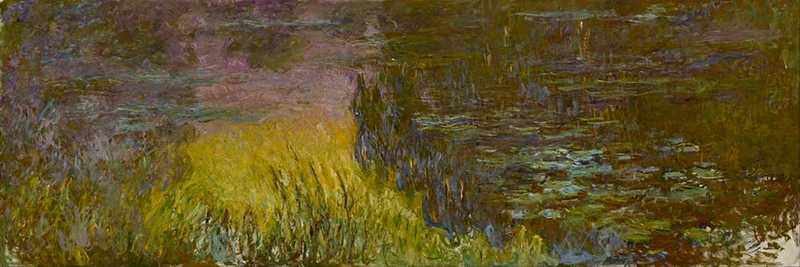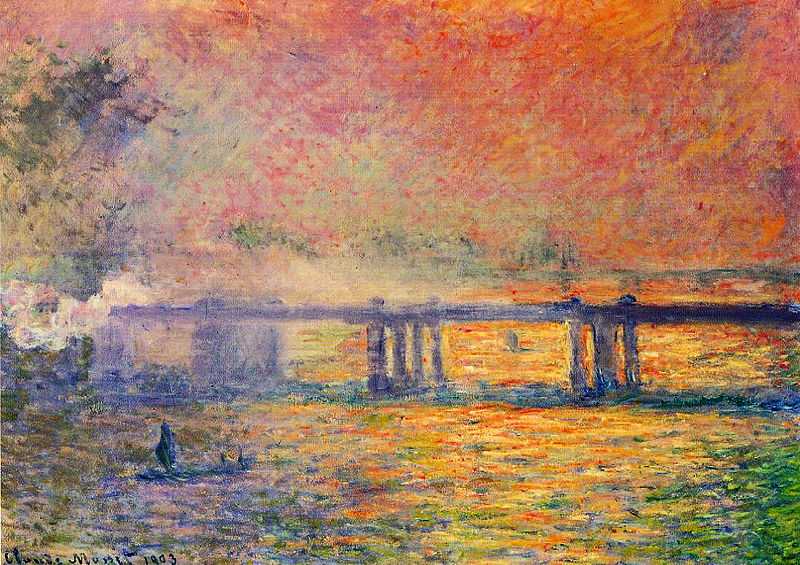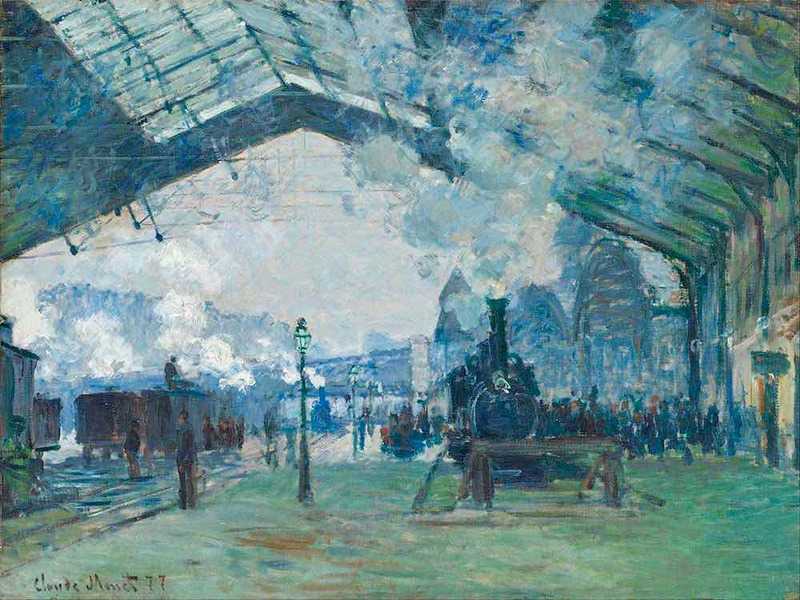1. The Woman in the Green Dress (1866)
In ‘The Woman in the Green Dress’, the model’s fashionable clothes show her to be a modern Parisienne woman.
At the same time, her pose is bold and dynamic, indicating that this is not a traditional portrait. Her facial expression is ambiguous, giving the whole painting an enigmatic feel.
Note how Monet uses the fabric to show off his skill at painting light and shadow.

The Salon
Monet submitted this work to the Salon (the annual exhibition of the Fine Arts Academy) in 1866. It was not only accepted by the jury, but received praise (something that the impressionists were not used to at this time).
Emile Zola, one of the Impressionists' main supporters, said the following about the dress:
“both supple and firm. Softly it drags, it is alive, it tells us quite clearly something about the woman”.
The Model
The figure depicted in the work is Camille Doncieux, Monet’s mistress who later became his wife.
Born in January 1847, Camille came from a bourgeois family and she was influential in shaping Monet’s figure paintings. Far from being simply a passive figure, Camille advised Monet on composition, clothes and appropriate poses, helping to bring an air of sophistication and elegance to many of his paintings.
Camille’s influence aided Monet in his attempts to capture the essence of the modern woman.
Camille featured in a number of Monet’s paintings throughout their relationship, from the controversial ‘La Japonaise (Camille Monet in Japanese Costume)' from 1876, to the tender, almost haunting painting ‘Camille Monet on her Deathbed’ from 1879.
Art historian and psychologist Mary Mathews Gedo has written extensively on the ways in which Camille redefined the role of the artist’s model. Gedo demonstrates that Camille’s professional capabilities made her far more than Monet’s muse. Instead, she was his partner and close advisor, especially in Monet's early career.
The Dress
It is likely that the green dress Camille wears in the painting was borrowed from Frédéric Bazille, who was struggling with his own painting at the time.
In January 1866, Bazille wrote to his mother complaining,
“What is really horribly difficult is the woman. And there is the problem of this green satin dress which I have rented and her blond head which I fear I will not do well.”
Bazille and Monet were very close and so when he eventually gave up on his painting, the dress probably made its way across to Monet’s studio on the rue Pigalle.
The HUGE canvass
Together with input from Camille, Monet set the scene for his seven-foot canvas. Camille added a fur-trimmed black jacket, perhaps to conceal the fact that the dress did not fit well, and a small feathered hat. They eventually chose a pose with Camille standing with her back to Monet, turning her face towards him and a gloved hand raised towards her face.
Today, Woman in the Green Dress is to be found in Bremen's Kunsthalle.
2. The Magpie (1869)
Towards the latter half of the 1860s, Monet began to experiment with snow-covered landscapes (snowscapes).
This may have been out of a desire to paint more transitory scenes than his other landscape works, capturing the snow in sunlight before it melts away.
Inspiration
Monet was not the first artist to be captivated by snow. Gustave Courbet had spent a great deal of time pursuing snowscape subjects in his work.
Monet also encouraged Camille Pissarro, Auguste Renoir and Alfred Sisley to join him in his new ambition and the artists each attempted their own snow-filled works.
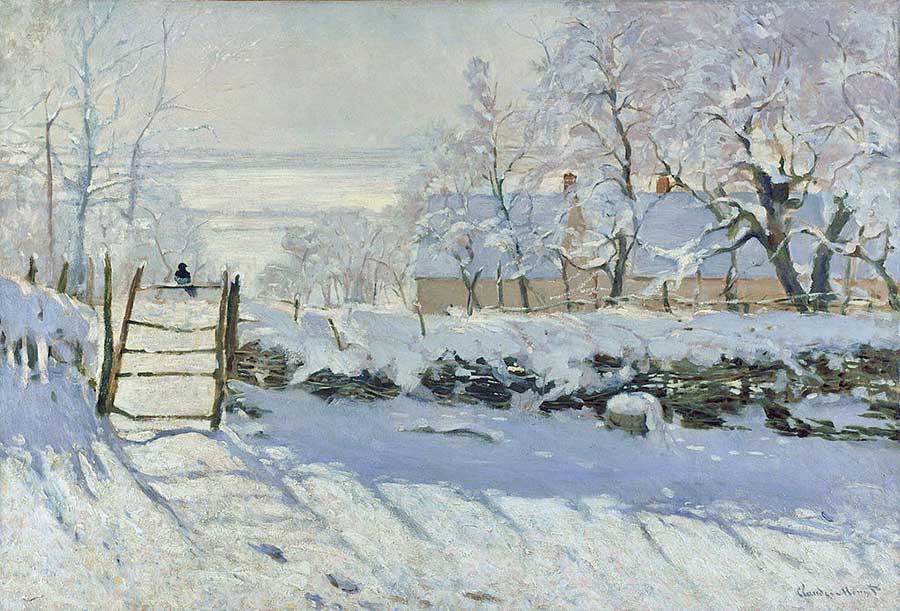
Over the course of his career, Monet produced 140 snowscapes, with the Magpie being the most famous of the lot. The Magpie also happens to be Monet's largest snowscape, measuring 130 x 89 centimetres.
The Scene
For ‘The Magpie’, Monet ventured into the countryside around Etretat in Normandy to execute the work en plein air. Monet was staying in a house paid for by one of his patrons, Louis Joachim Gaudibert.
The scene that Monet depicts in ‘The Magpie’ is still and serene. He chose to paint the snowscape in sunlight, created a contrast between light and shade. The shadows of the wall and gate help to transform the great expanse of snow in the foreground into a poetic image of a winter morning.
The Palette
What makes this painting particularly notable is the extremely pale palette that Monet used. At the time when he was painting, such pale colours and bright light were very unusual in artworks. Hence, whilst the scene itself is serene, this painting represents a daringly novel approach.
Rejection
The Magpie was rejected from the 1869 salon, likely because of its pale palette. In the words of Felix Fénéon, a contemporary art critic,
“accustomed to the tarry sauces cooked up by the chefs of art schools and academies, [the jury] was flabbergasted by this pale painting.”
Today, Monet's The Magpie is one of the Musee D'Orsay's greatest treasures.
3. The Frogpond (1869)
Writing to Frédéric Bazille on 25 September 1869, Monet confessed: “I do have a dream, a painting, the baths of La Grenouillère, for which I have made some bad sketches, but it is only a dream."
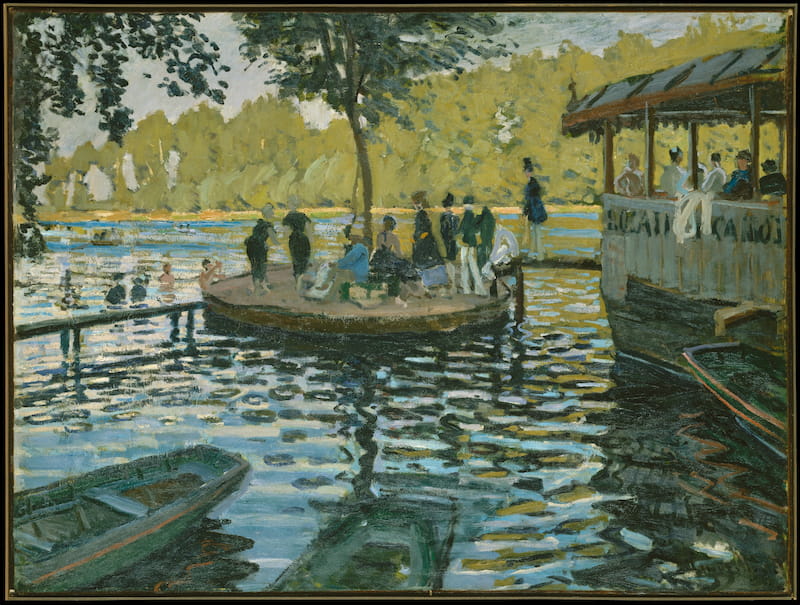
A Joint Venture
In the 1860s, La Grenouillère (of 'Frogpond' in English) was a popular destination on the Seine River, attracting crowds from Paris to enjoy sunny days on the water.
New railway lines made it easy to travel from Paris, opening up the countryside surrounding the city to day-trippers and tourists.
La Grenouillère had a floating restaurant, dance hall and tables by the river. There was also the opportunity to go fishing, boating and swimming. These activities were coupled with a rather raffish reputation which made it an even more interesting subject to paint.
Painted in 1869, this painting was a joint project between Monet and Renoir, both of whom began painting scenes from the resort of La Grenouillère during the summer months.
Ordinary People
The Impressionists sought to depict ordinary people and everyday life and so holiday-makers made perfect subjects.
Renoir was particularly attracted to scenes of gaiety. He once remarked that:
“For me a picture has to be something pleasant, delightful, and pretty — yes, pretty. There are enough unpleasant things in the world without us producing even more.”
Monet's Style
Monet’s deliberately loose, easy painting style echoes the scene, mirroring the laidback atmosphere of the resort.
He painted quickly, setting up his easel next to the river and creating a series of sketch-like artworks. The resulting images epitomise the lifestyle shifts taking place in France during this period, where free time was transformed into a pursuit of pleasure that was accessible to all classes.
This painting was shown at the Second Impressionist Exhibition of 1876 and it is thought to have been bought by Édouard Manet, passing on to his widow Suzanne Manet after his death.
Side by Side
Renoir, by contrast, painted a little more carefully, paying particular attention to the clothes work by ladies. This is unsurprising: Renoir was mainly a portrait painter who was particularly skilled at capturing the female form. Here are the two pictures next to each other (Renoir on the top; Monet on the bottom).
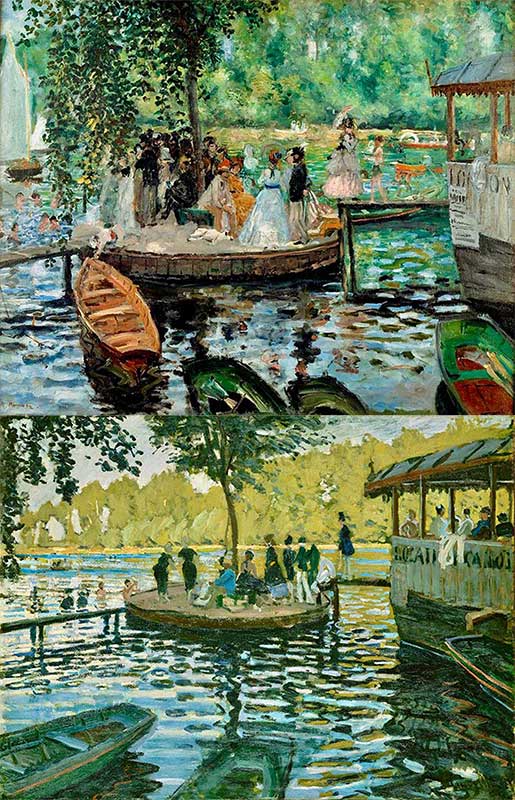
Where can I see it today?
Paul Durand-Ruel then purchased the work, selling it to Mr and Mrs H. O. Havemeyer in New York. The painting now forms part of the Havemeyer Collection at the Metropolitan Museum of Art in New York.
4. Impression, Sunrise (1872)
Impression: Sunrise is one of the most important paintings in Impressionism.
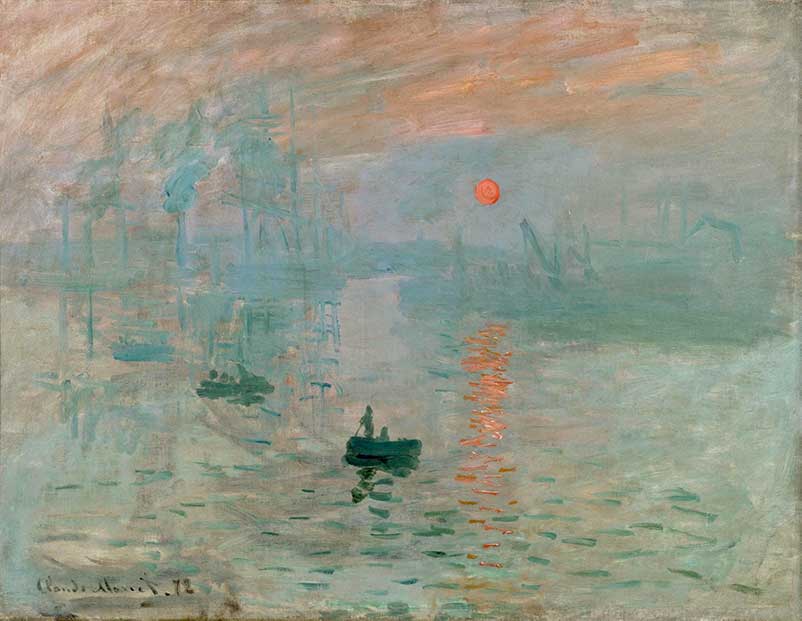
Painted by Monet from a hotel room overlooking the harbour at Le Havre in November 1872, Impression: Sunrise encapsulates the three key principles of impressionism:
- It is a painting of a modern scene, as can be seen from the derricks and smoke being pumped out of chimneys in the background.
- It uses light, shadow and bright colours.
- It was painted quickly, using broad brush strokes, and aimed to capture the impression that the scene created on Monet - rather than faithfully reproduce the harbour.
Coining the term 'Impressionism'
When it was exhibited at the Impressionist’s first independent exhibition of 1874, ‘Impression, Sunrise’ received an underwhelming response.
Many critics did not bother to even comment on the piece. The exception was Louis Leroy, who criticised the painting for being ‘Impressionistic’, hence the rise of ‘Impressionism’ and the ‘Impressionists’.
In fact, Leroy was more acidic than that. He famously wrote:
'Impression! Of course. There must be an impression somewhere in it. What freedom ... what flexibility of style! Wallpaper in its early stages is more finished than that.'"
Importance
It is only with the benefit of hindsight that the work has taken on such significance. It has gradually risen in fame to become one of the best known paintings of the Impressionist movement. Indeed, it is one of our Top 10 Paintings of All Time.
Learn more on our Impression: Sunrise page.
5. Gare Saint-Lazare (1877)
As part of his pursuit of painting modern subjects, Monet frequently returned to trains.
During the 19th century, trains became a pervasive part of everyday life and by the turn of the century railways crisscrossed Europe and stations punctuated every major city and town.
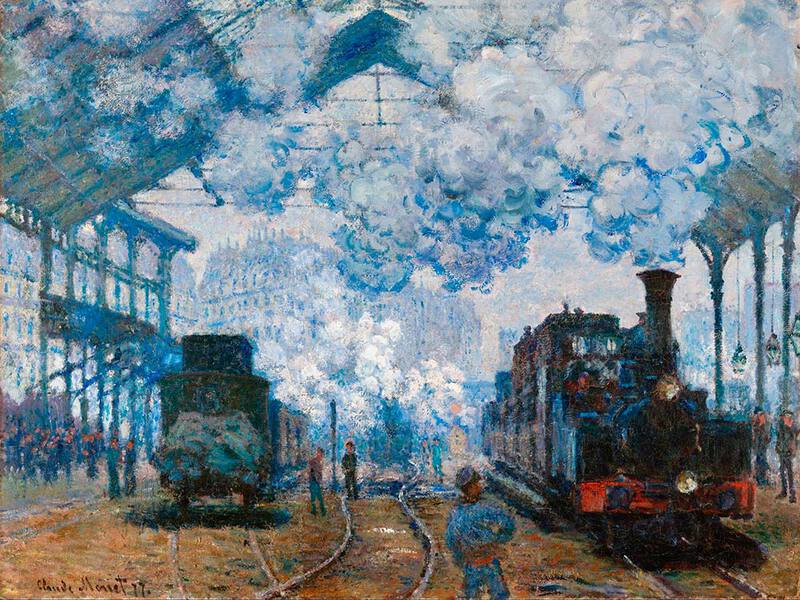
Gare Saint-Lazare
One station, the Gare Saint-Lazare in Paris, was the setting for 12 paintings by Monet in 1877.
Monet was given permission to paint the station at the start of the year. He painted all of the works in a short three month period, between January and March, submitting seven of the paintings to the Third Impressionist Exhibition held in May 1877.
Blagging his way in ...
The story goes that Monet dressed up in his finest clothes and marched to the station to request access to the platforms.
Acting out the part of a gentleman with supreme confidence and aplomb, Monet was shown directly into the station master’s office and the surprised official, assuming he was a man of great importance, granted all his demands.
Privileged access
This audacious feat meant that Monet had a privileged view from which to paint the Gare St-Lazare. The platforms were cleared of people, the trains were delayed, and extra coal was added to the engines to increase the billowing effects of the smoke.
Among the paintings Monet produced of the Gare Saint-Lazare, there is a significant range of execution, from the subject to the technique.
Most of the works are quick sketches but two were finished in extreme detail. As Georges Rivière remarked on seeing the paintings at the Impressionist Exhibition,
“these paintings are amazingly varied, despite the monotony and aridity of the subject. In them more than anywhere else we can see that skill in arrangement, that organisation of the canvas, that is one of the main qualities of Monet’s work."
Where can I see them?
The 12 members of Monet's Gare Saint Lazare series are dotted around the globe. The one pictured above is in the Hogg Collection, in Cambridge Massachusetts. Four are in private collections. And the remaining seven are held in the Musee d'Orsay and the Musee Marmottan Monet (both in Paris), London's National Gallery, and in Chicago, Japan, Germany and Italy.
6. Bordighera (1884)
This bright painting, depicting a coastal scene in brilliant sunlight, was one of a number of works Monet began during a stay in Italy in 1884.
Having travelled to the town by rail in 1883, he returned again in 1884 and stayed for three months.
The town of Bordighera
Situated on the Italian Riviera and near the French border, the town of Bordighera served as a setting for a range of paintings by Monet.
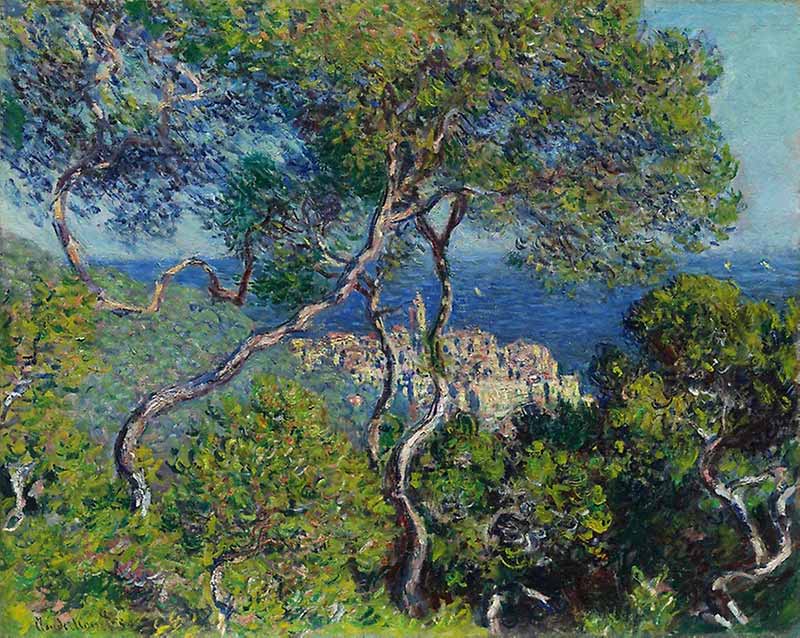
What particularly fascinated him was the effects of the harsh sunlight on the landscape. In a letter to fellow artist Auguste Rodin, he described how he was
"fencing, wrestling, with the sun.”
Heat
Unlike his softer works from northern France, this painting is stark. One can almost feel the Mediterranean heat emanating from the scene. The gnarled trunks and branches of the scrubby trees interlace in the foreground and the town and blue sea can be glimpsed behind.
Monet's moans ...
Monet lamented the state of the vegetation, writing to his wife Alice:
“It is extremely difficult to do and it is very time-consuming, mostly because the large self-contained motifs are rare. It is too thick with dense foliage, and all you can find are motifs with lots of detail, jumbles terribly to paint and I, in contrast, am the man of isolated trees and large spaces.”
Despite his complaints, it is evident that he enjoyed the challenge. He painted over 40 works in and around the area of Bordighera, extending his stay from three weeks to as many months.
Where can I find it now?
The above painting, simply entitled Bordighera, is now found in the Art Institute of Chicago. Other paintings of the same location are found in the Met in New York (Palm Trees at Bordighera) and in the Museum Barberini in Potsdam, Germany (Villas at Bordighera and Strada Romana at Bordighera).
7. Haystacks (1889-1892)
Considered to be some of his finest works, Monet’s Haystacks are a series of paintings depicting fields in different light, conditions and seasons.
The haystacks in the series were located close to Monet’s house in Giverny. He convinced the farmer who owned to fields not to move them through the autumn and winter, giving him enough time to paint the haystacks numerous times.
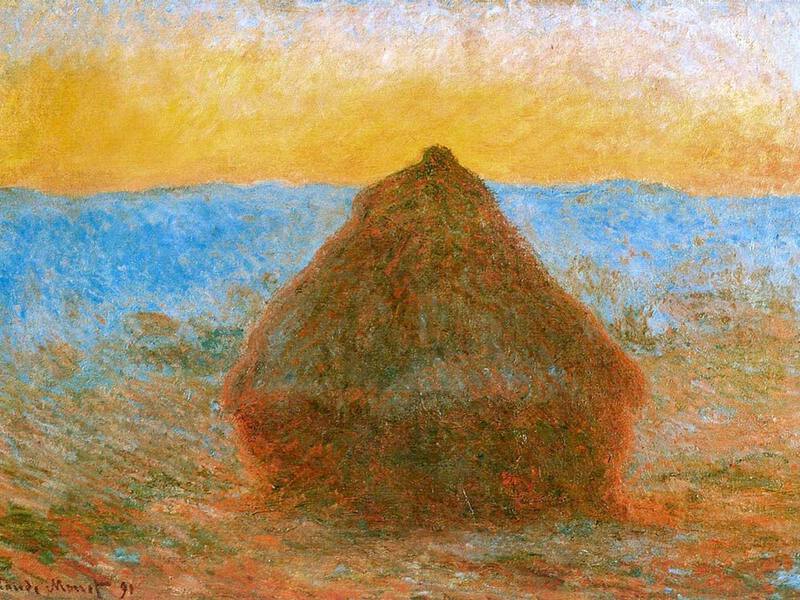
The Haystacks Series
The result was a series of over 30 paintings, each one capturing a certain time of day, varying weather conditions and the gradual changing of the seasons.
In some paintings, the haystacks are cloaked in snow, in others they are bathed in the warm, pink light of a sunset. Painting en plein air, Monet was able to capture the subtleties of natural light, from the shadows that fell on the ground to the delicate hue the haystacks took on at different times of the day.
The effect is calm, poetic and almost abstract.
A challenging scene
From Monet’s letters, it is possible to understand some of the challenges presented by painting in natural light during the winter months.
Writing to Gustave Geoffroy, he admitted
“I am working very hard, struggling with a series of different effects (haystacks), but at this season the sun sets so fast I cannot follow it. […] The more I continue, the more I see that a great deal of work is necessary in order to succeed in rendering what I seek."
What happened next?
These works were the first series that Monet chose to exhibit together. In May 1891, 15 went on display at Paul Durand-Ruel’s gallery in Paris.
The impact of all the works hung together must have been impressive. And it certainly attracted the buyers. By this stage, Monet was becoming a household name and his Haystacks sold quickly for prices of around 1,000 francs each - many going to American buyers.
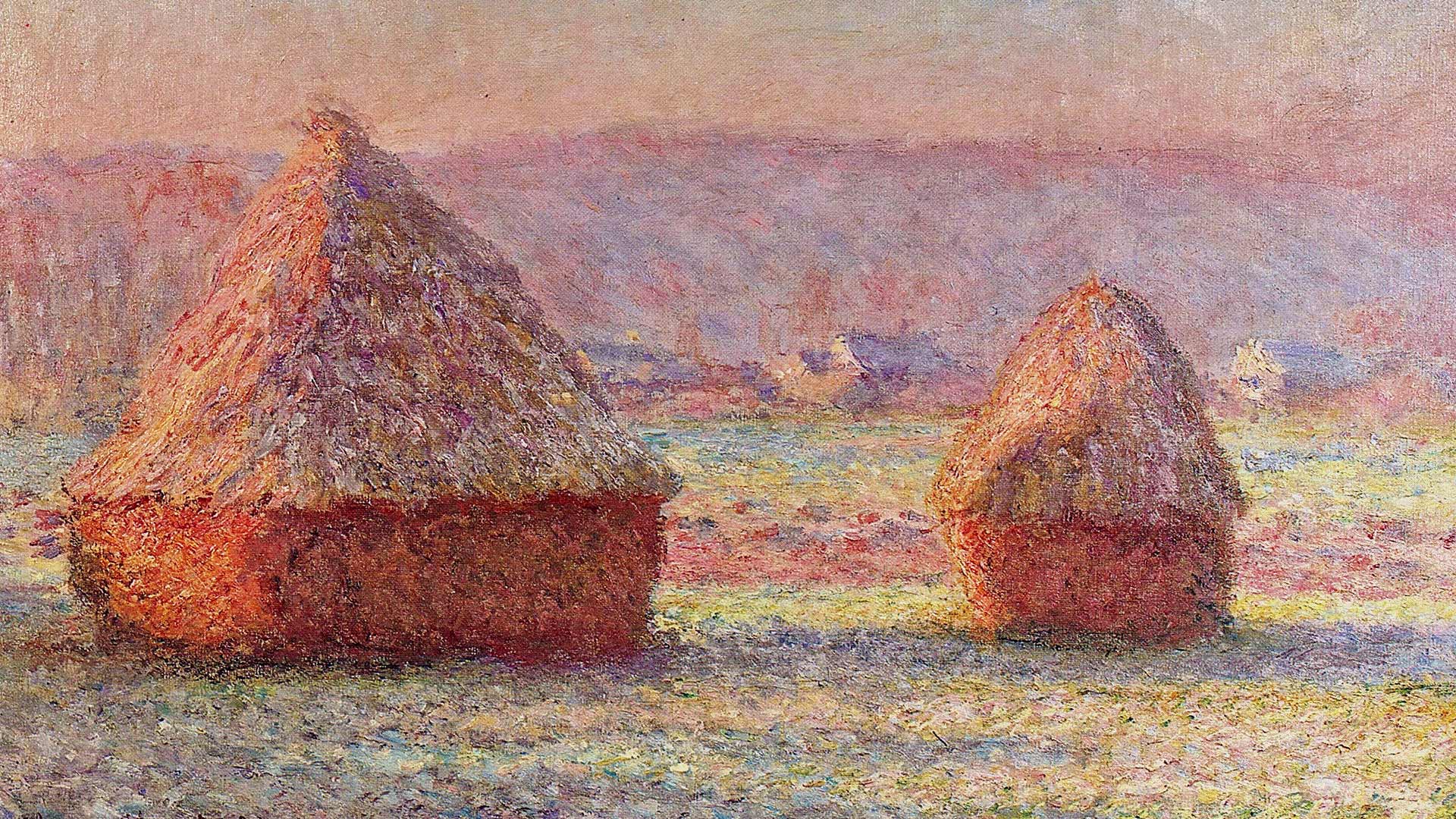
Interesting fact...
Roughly half of Monet's series feature one Haystack; the others feature two.
Where can I find them now?
These days, versions of Haystacks are held in a number of galleries around the world. The Art Institute of Chicago tops the list with six versions. Fifteen other institutions each hold one of series, including the d'Orsay, the Marmottan Monet and the National Gallery of Scotland.
Learn More on our Haystacks page.
8. Rouen Cathedral (1892-3)
By the 1890s, Monet had become captivated by the idea of painting the same subject several times in varying conditions.
He wished to explore the effects of natural light in great detail, choosing static scenes that allowed him to study the interplay of shadows, colour and highlights.
Rouen
Rouen and its medieval cathedral proved to be an ideal subject to allow him to achieve this effect and he completed over 30 views of the motif between 1892-93.
It is known that Monet worked on several canvasses at the same time as the light changed through the day. This shortened the time it took to paint the entire series, and allowed Monet to wait until the weather conditions were just right before recommencing work on a particular canvas.
But the sight of Monet rushing between up to 10 canvasses, trying to capture the fleeting effects of light, must have been quite amusing!
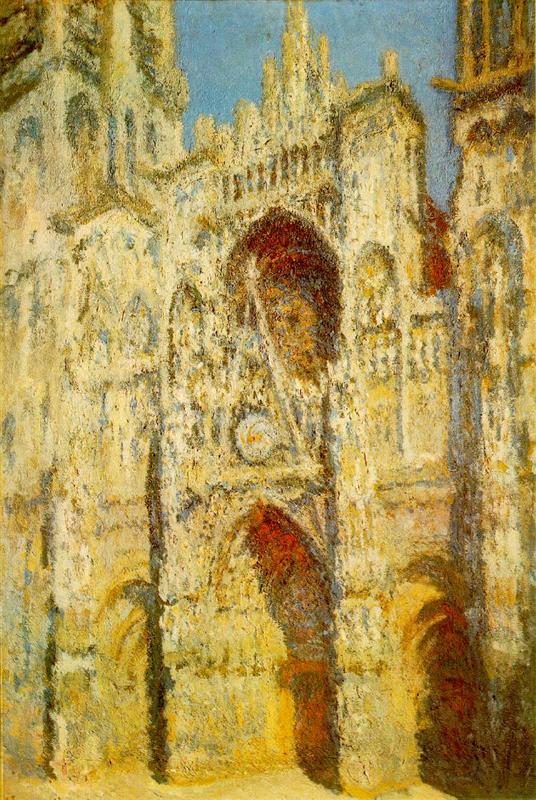
Painting the Rouen Cathedral series
The view of the cathedral was achieved by painting from second-floor windows of a number of shops along the rue du Grand-Pont.
Whilst the works were started in Rouen, they were finished in Monet's studio at Giverny. He intended for the paintings to be hung together and so he made slight adjustments to some of the pieces so that they made sense as a series. Consequently, many of the paintings are dated to 1894, when he would have signed them in the studio.
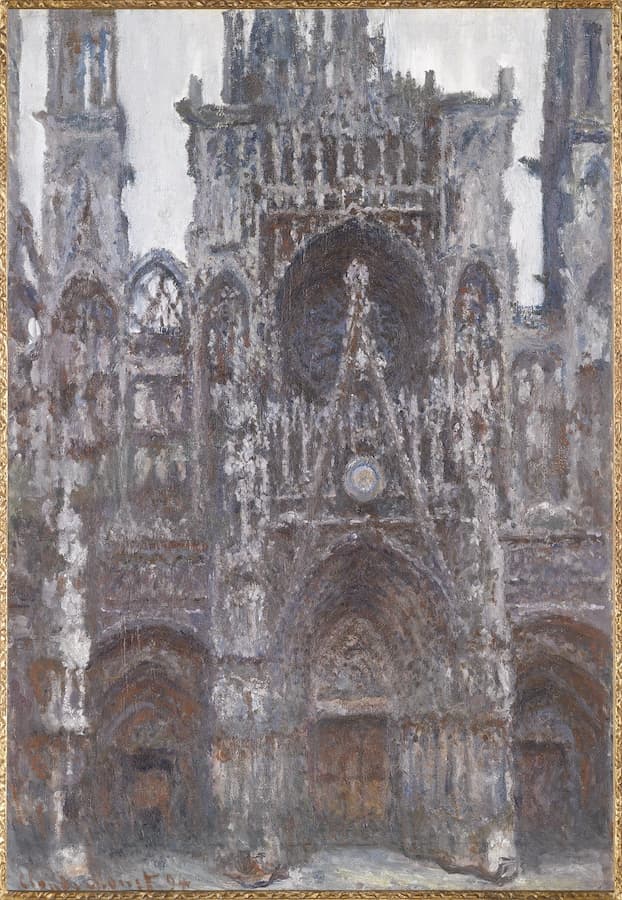
Like his earlier Haystacks series, Monet chose to show 20 of his Rouen Cathedral paintings in a solo exhibition at Galerie Durand-Ruel in Paris. The exhibition took place in 1895 and was a huge commercial success.
Where are they now?
As with his Haystack series, Monet's Rouen Cathedral paintings are dispersed around the world. Paris' Musee d'Orsay leads the way with five versions, though it often lends some of them out.
Learn more on our Rouen Cathedral page.
9. Houses of Parliament (1899-1900)
Monet regularly returned to the Houses of Parliament in his paintings.
He chose to paint the structure from a number of views, including the terrace of St Thomas Hospital and a location on the opposite bank near Westminster Bridge.
In a period of just three years, between 1899 to 1901, he produced almost a hundred paintings of the River Thames.
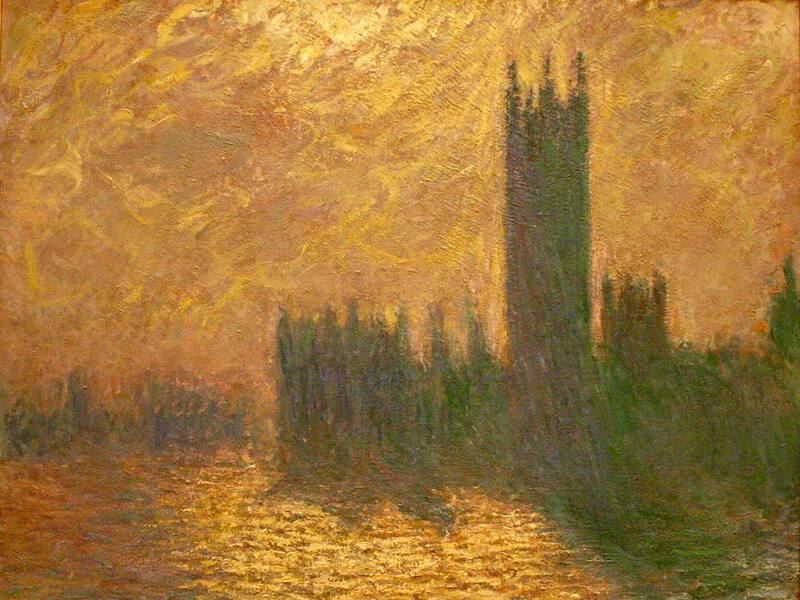
Fog
One recurring theme in Monet’s paintings of London is his engrossment with the effects of fog on the city.
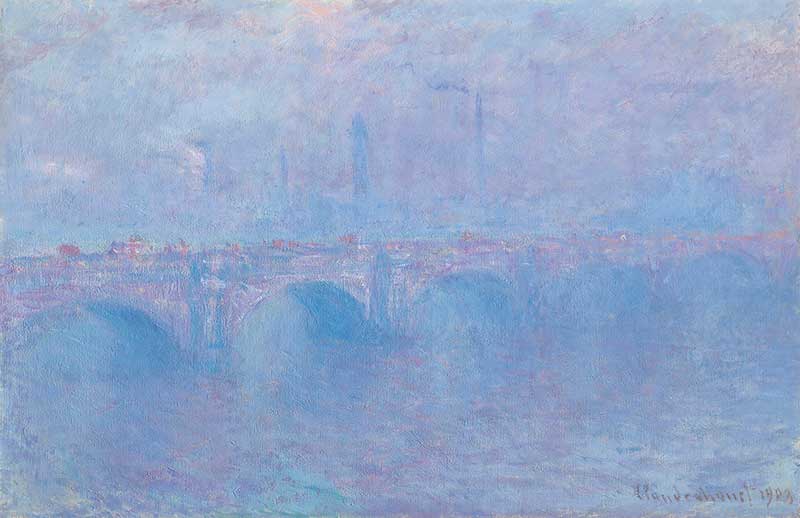
A large majority of his works feature hazy views, partially obscured by mist and fog. The solid, distinctive architecture of the Houses of Parliament allowed Monet to play with light effects and fog.
In ‘Londres, le Parlement. Trouée de soleil dans le brouillard’ (London, Houses of Parliament. The Sun Shining through the Fog) for instance, the entire scene is painted in hues of pink and blue. The tower of the Parliament buildings is painted almost like a shadow.
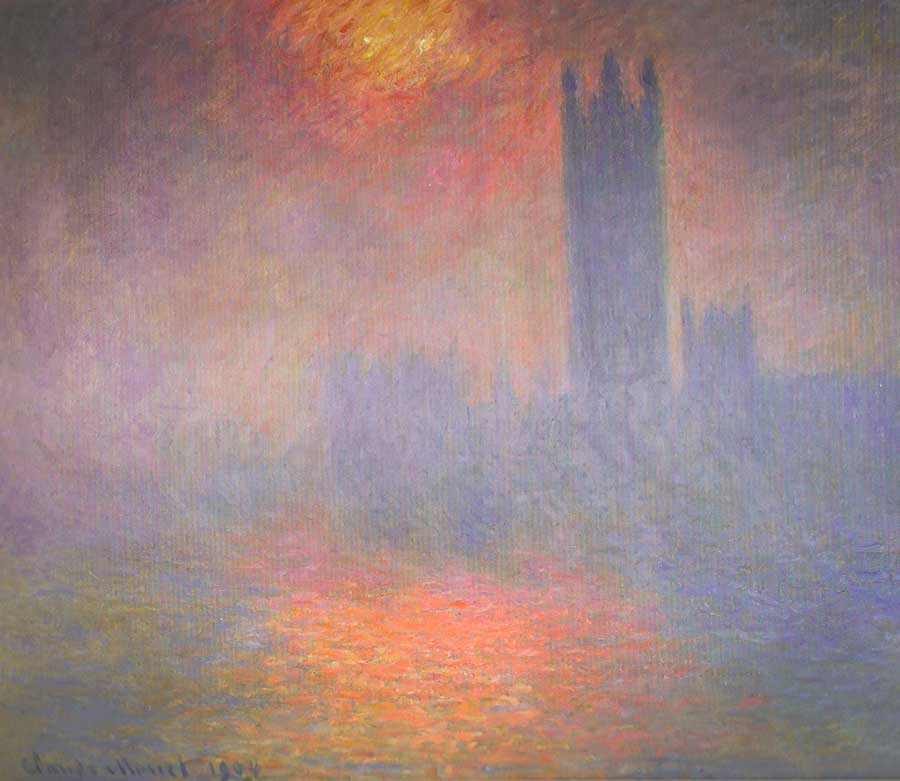
Monet's brushstrokes
Monet was able to create these effects by using the short, feathered brushstrokes that had become characteristic of the Impressionist style. He blurred the boundaries between the water, sky and the building to create a sense of dense mist.
In 1903, he wrote to Durand-Ruel confessing,
"I cannot send you a single canvas of London ... It is indispensable to have them all before me, and to tell the truth not one is definitely finished. I develop them all together.”
When they were eventually completed, Monet exhibited over 30 works of the River Thames at Galerie Durand-Ruel.
10. Water Lilies (1889 onwards)
It is impossible to mention Monet’s top 10 paintings without referencing his Water Lilies series.
These were the 250 or so works that dominated the latter period of Monet's life, from 1889 up until his death in 1926.
Giverny
Together with his wife, Alice, Monet created a water garden in the Japanese style, filling a large pond with colourful waterlilies that soon became the centre of his artistic world.
Monet’s water garden occupied his mind, saving him from the crushing reality of his later life that saw the death of Alice and his son, the outbreak of the First World War and his own diagnosis with debilitating cataracts.
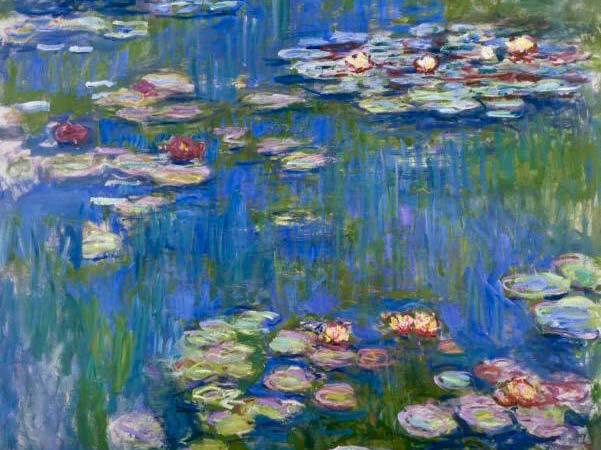
Through this period of extreme turmoil, Monet set about creating yet more paintings of water lilies, which gradually became ever more abstracted and formless.
The Grands Decorations
The series culminated in a collection of enormous, monumental paintings, each over two metres high.
In these works, his waterlilies have morphed into a swirling, sweeping haze of colour. In the words of one commentator,
“It is a great area of drifting, nebulous colour with which it is very difficult to establish any consistent relationship. The only proper reaction would be to dive into it and drown.”
The results of this overwhelming end to Monet's remarkable career, known as Monet's Grand Decorations, are now housed in Paris' Musee de l'Orangerie.
Here are some of Monet's Grand Decorations, measuring up to 2 x 17 metres:



Learn More about Monet's Water Lilies on our Monet and Giverny page.

